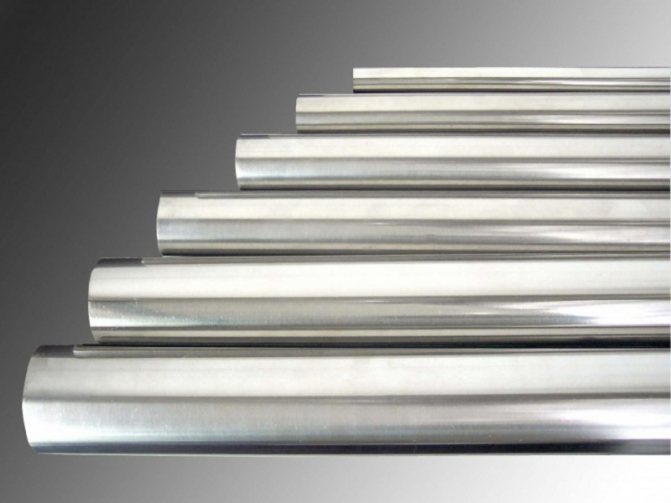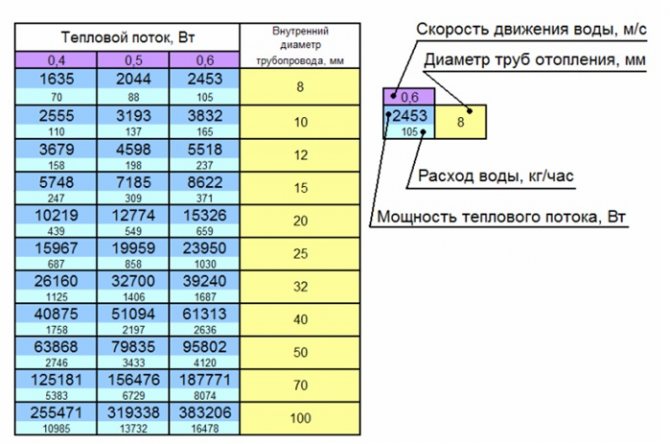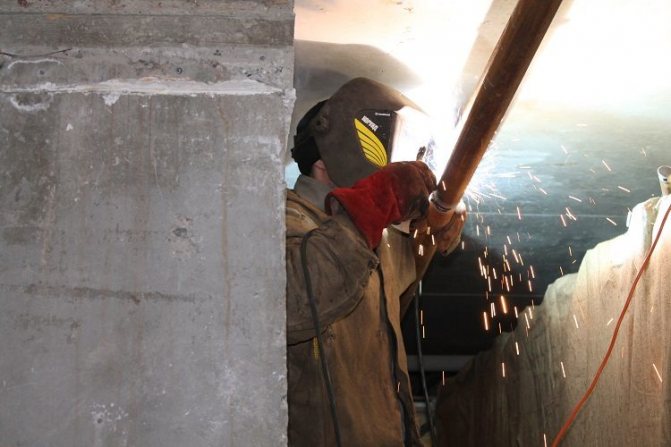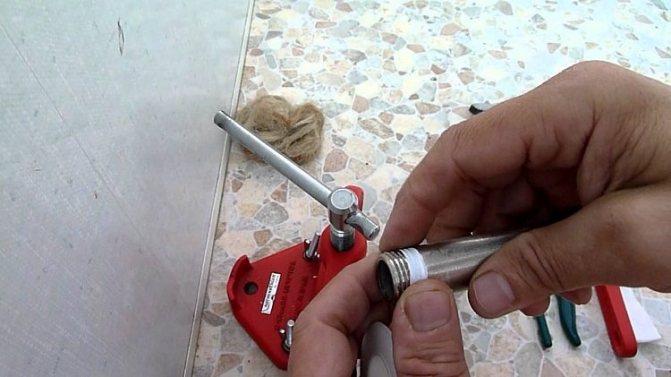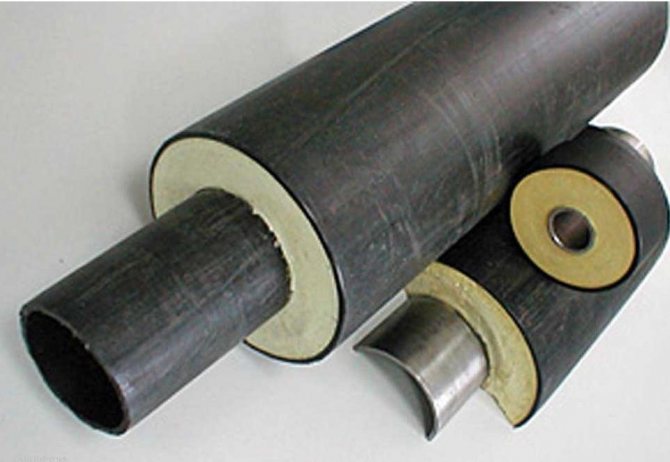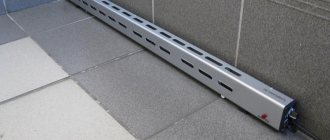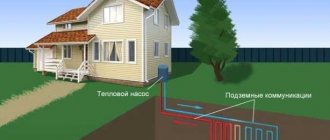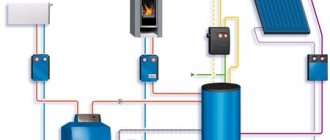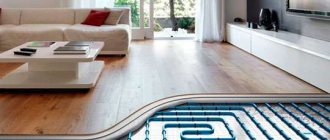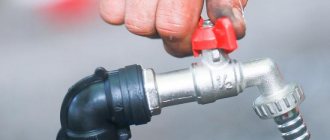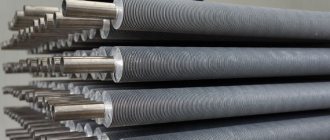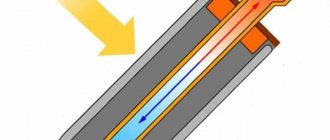Pros and cons of metal
The characteristics of pipes are determined by the technological nuances of their production. Metallurgical plants use processes to give the finished product certain properties. Products can be solid-drawn or welded. The former are formed using sophisticated equipment, while the others are sewn from sheet metal.
The main advantages of the products:
- Strength. Metal pipes are indispensable in the construction of high pressure lines.
- Low thermal expansion. This eliminates the need for thick-walled products.
- Almost one hundred percent gas tightness. This is a very important condition for creating a complete closed heating circuit.
- High thermal conductivity. A very important point for the organization of heating systems in residential buildings. The surface of the metal transfers heat to the surrounding air, partially performing the functions of heating devices.
- Availability. The cost of the metal is low, which is of great importance when arranging budget options for heat supply.
Disadvantages:
- Corrosion susceptibility. Metal poorly resists oxidative processes and aggressive environments.
- Electrical conductivity. Although very conditional, but still a negative factor. It is of particular importance when arranging a heating system with an electric boiler.
- Rigidity. It is possible to bend the line only when exposed to heat. For installation, a lot of connecting and shaped elements are required.
- Large mass. During installation, you have to make a lot of physical efforts in order to correctly position the section of the highway.
The choice between plastic and metal for the arrangement of heating circuits
The choice between plastic and metal for the arrangement of heating circuits
Between plastic and metal, metal pipes are more often preferred for heating, although the popularity of plastic pipes in recent decades is so great that new materials have almost displaced metal from the pipe market, but metal is still the preferred option for heating circuits.
It is enough to compare the technical features of metal and plastic to make sure that it is more reliable when used as a material for heating systems.
Plastic in the heating system
Plastic pipes have the following performance characteristics:
- the value of the permissible operating water temperature is 95 degrees,
- the value of the working pressure is not more than twenty-five atmospheres.
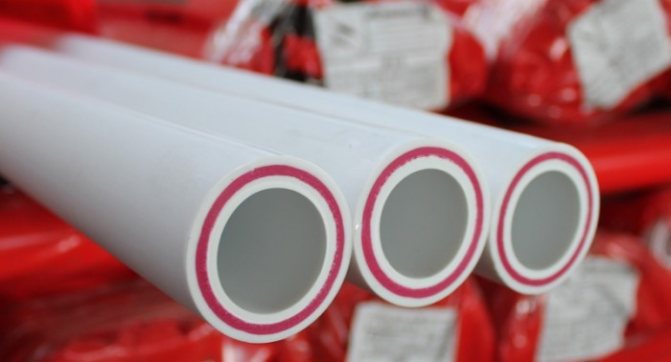
At first glance, this is quite acceptable for use in heating, where the operating temperature and pressure usually do not exceed these values.
However, the maximum pressure data corresponds to the declared one only at water temperatures up to 20 degrees. With an increase to the limit of 95 degrees, the working pressure in the plastic pipes will drop to eight atmospheres.
Note! When plastic pipes are used at the maximum permissible level, their service life is reduced to about ten years.
In winter, in case of frost, the management company may decide to increase the water temperature. In this case, the incoming liquid may not be 95 degrees, but all 150.
We recommend that you familiarize yourself with: Using paint for the surface of galvanized pipes
Do not forget that heating mains are inspected about once a year. During these checks, the ultimate pressure is increased by three times the values during normal operation.Therefore, plastic often fails these tests.
Metal pipes
The main condition is that the pipes for heating are strong and reliable. Metal products are able to withstand even extreme loads, and in this plastic analogues cannot be compared with them, despite the susceptibility to corrosion, which reduces their service life, and their large weight, which makes installation and transportation difficult.
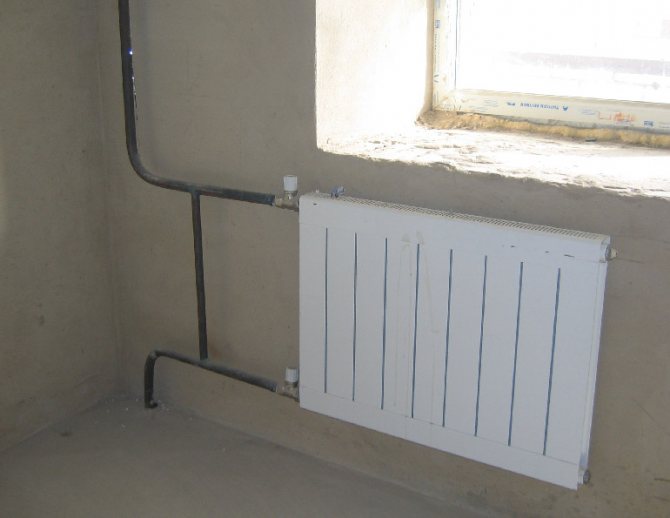

Reliability for heating mains is the most important quality, especially since manufacturers use various alloys for anti-corrosion resistance, which do not have these disadvantages.
Types of pipes
Cast iron
The composition is a complex iron-based alloy. The molten mass is excellently molded and differs from pure steel in its increased carbon content.
Pipes made of cast iron for heating systems are rarely used. When their use is fundamental, then operations are performed to improve the insulating characteristics:
- joints are sealed with cuffs and special couplings
- the inner and outer walls are treated with a protective film
Manufacturers supply the market with products with a diameter of 50 to 300 millimeters. Compared with plastic counterparts, cast iron has an advantage in mechanical strength.
Copper
Copper pipe
The material has exceptional thermal conductivity. Along with sufficient mechanical strength, it is characterized by a long service life.
Copper pipes are used in places where welding work is categorically unacceptable. These highways did not receive mass distribution due to their high cost.
For heating systems, there are two types of these pipes:
- Made of pre-work-hardened material. Products gain increased mechanical strength. Deliveries, as a rule, are carried out with purlins cut to the required dimensions. Their diameter ranges from 22-54 mm.
- Made from welded copper. Products are distinguished by high malleability and manufacturability. They are supplied to the market in coils with a diameter of 6-22 mm.
Separate sections of the highways are joined together by welding.
Black steel
It is the most common material for domestic heating systems in the 70-90s of the last century. This steel grade is not resistant to corrosion and is unlikely to leave behind positive memories for homeowners. Although the service life was declared at 25 years, the problems started much earlier.
Namely:
- Depressurization of the system. This was partly due to the incorrect operation of the pipelines. They could serve for a long time, provided that the system was filled with water all year round, which was absolutely not observed.
- Deposits. The inner walls are a great place to collect salt, sand and other impurities. As a result of the decrease in the diameter of the mains, the efficiency of their work also decreased.
Cink Steel
Galvanized pipe DN 32
The protective top layer has dramatically changed the performance characteristics of conventional steel. The pipes began to serve several times longer. In many "Stalinkas" these highways serve to this day. However, the quality of modern products raises many questions from both installers and consumers.
In fairness, it should be noted that there are enough high-quality products on the market. Heating made of zinc-coated metal pipes is durable. The material itself remains strong and resistant to aggressive environments.
Separate sections are mounted on threaded joints, since welding destroys the insulating layer.
Of the shortcomings, two can be noted:
- Higher cost than traditional steel.
- Threaded joints are much more time consuming than welding or brazing.
Stainless steel
In theory, stainless steel pipes can be used to equip heating. Moreover, the installation can be performed both by welding and by means of threaded connections. Such highways are practically not limited by any terms of operation. The building itself will become unusable faster.
However, the extremely high cost of anti-corrosion steel precludes widespread use of the material. Corrugated counterparts, on the contrary, are successfully used and become more and more popular every year. Their price is quite acceptable, and consumer demand is growing due to the many advantages of the material:
- You don't need a lot of tools to complete the installation work. The most primitive pipe cutter and two gas switches are enough.
- High performance parameters. The metal can withstand the boiling point of water and the pressure of 12 kgf / sq. Cm.
- Pipes are connected using compression fittings and silicone seals. They are easily joined by means of fittings and are clamped with threaded connections.
- The pipes are easy to mold. No thermal action or great force is required to obtain the desired bend.
Add to bookmarks
Characteristics according to GOST
Production is carried out in two ways:
- welding;
- casting.
Seamless steel pipe
Based on this, welded and seamless stainless steel pipes are distinguished for heating. The maximum diameter of welded products is much larger than that of seamless ones and reaches 2.5 meters. They are welded by oven or electric welding. The latter can also be forgiven in a gas chamber.
State standard No. 3262-75 determines that steel pipes for heating a house should be produced in sizes from four to twelve meters. In addition to the measured, they can be made to a special order of unmeasured length, in lengths from one and a half to four meters. The inner section of the products varies from six to one hundred and fifty millimeters, and the outer diameter is, respectively, from 102 to 165 millimeters. Depending on the wall thickness, steel pipes for heating are divided into:
- lungs;
- ordinary;
- reinforced.
This characteristic also determines the weight of the product, which is calculated in kilograms per meter of the product. The calculation is carried out taking into account the density of the material, which is 7.85 g / cm3. For finished products, the standard allows a maximum deviation:
- the outer diameter of steel heating pipes is no more than 0.4 mm for products with an internal section of up to 4 cm. For products with a nominal diameter of more than 4 cm, the deviation is indicated as a percentage and is 0.8;
- mass - no more than eight percent;
- geometry - on one meter, the curvature should be in the aisles of one and a half percent for products with an internal diameter of up to 2 cm.And for pipes, the nominal passage of which is more than 2 cm, the deviation is no more than two percent.
Galvanized steel pipes for heating according to GOST 3262-75 are 3% heavier than usual. The zinc coating must be uniform and at least 30 µm thick. On the ends and threads, its presence is optional.
The ends of the products also differ, which can be smooth, threaded, or with a coupling. The thread is long and short. It can be applied to one or both sides of the product. In addition, chamfers can be made at the request of the customer. In this case, the metal should not delaminate at the ends. Slight scratches and other defects are allowed on the outer surface, which do not affect the characteristics of the products.
Particular attention is paid to zinc coating, if such is provided during the production process. The protective layer of a stainless steel pipe for heating must be smooth, without bubbles and flaking. Threads can only be cut after the protective layer has been applied.
Finally, galvanized steel pipes for heating are pressure tested. For this, hydraulic tests are carried out, according to the results of which ordinary pipes must withstand a load of at least 25 atmospheres, and reinforced ones - at least 32 atmospheres. At the request of the customer, this figure can be increased to 50 atmospheres.
Classification and characteristics
Two-pipe heating circuit with forced circulation of the heat carrier
According to the manufacturing method, iron pipes can be seamless, hot or cold drawn and electrically welded. Seamless rolled steel is more reliable and designed for higher pressure. The choice of such pipes entails an increase in the cost of installing a heating system, since their cost is much higher than that of electrowelded ones.
The main characteristics are:
- Size and weight. The size of the product is determined by the inner and outer diameters, nominal bore diameter, wall thickness and pipe length. All these physical quantities, including the mass of 1 linear meter. m pipes, regulated by GOST and TU. Using them, you will easily make a choice in favor of one or another type of rolled metal. Diameters and wall thicknesses are measured in millimeters, length in meters, and mass in kilograms or tons.
- Strength. Strength characteristics include the ability of the pipeline to withstand a certain pressure (operating, nominal, test, excess) and the temperature of the environment. Pressure is measured in pascals and temperature in degrees Celsius or Kelvin. These are the main characteristics that guide the design of heating systems.
- Material. It can be carbon steel, stainless steel, carbon iron, alloy and non-ferrous metal.
What pipes are better for heating
Heating scheme of a private house with natural circulation of the coolant
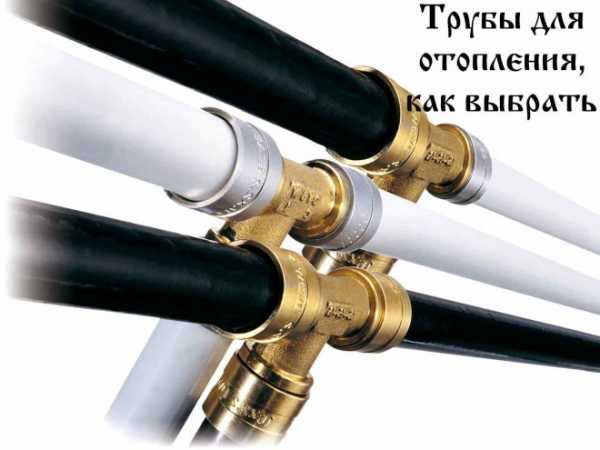

Hello everyone, today I will tell you which pipes are better to make heating, this is of course my personal opinion, nevertheless, I am sure that it will coincide with many.
So, from which pipes it is better to make heating in the house, such a question is probably asked by everyone who makes repairs in an apartment, or completes the construction of his private house
If you are thinking about the question of which pipes it is better to make heating from, then you most likely chose a boiler as a heating source, gas or electric, it does not matter. Now it remains to lay a network of pipes throughout the house in order to connect your boiler to all radiators
What you are most likely to look at when choosing pipes for heating. Understand this is the price and ease of installation. Previously, there was no question with this, metal pipes were used everywhere, but technologies are developing, and today the choice is huge, which is just not there.
Types of pipes for heating
- Steel
- Stainless steel
- Copper
- Plastic
- Reinforced plastic
Steel tubes
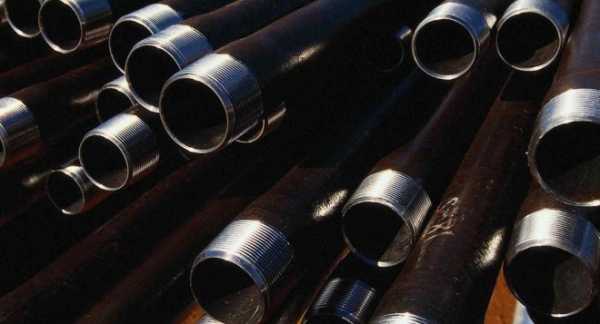

Steel pipes were the pioneers in engineering communications, from which pipes were made, if not metal, the most popular product was. Many argue that it is better to make heating from steel pipes, maybe so. They are very strong, withstand good pressure, and have a relatively low coefficient of linear expansion.
Steel pipes are reliable, but not cheap, and besides, they are not very convenient to use. In modern home decoration, they try to hide all communications under finishing materials, but with steel pipes it will be difficult to do this. In addition, a qualified welder is required for the installation of steel pipes, since there will be many corners, turns and other things.
Plastic pipes
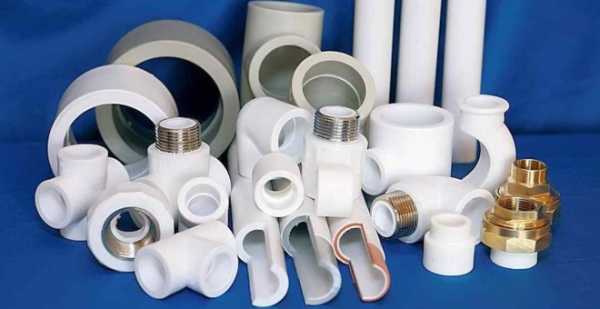

Also, many people answer the question of which pipes for heating are better, of course, plastic. Cheap, fast and everything can be done by hand. Yes, plastic pipes are probably the cheapest of all pipes, and for their installation you only need to use a special "iron" and couplings to connect.
But plastic is not as durable as it might seem at first glance. I mean, when hot water flows through the plastic, it will expand and lengthen, and then vice versa. Therefore, not all types of plastic are suitable for this.
Reinforced-plastic pipes


If you ask me which pipes are better for heating, then I will answer that metal-plastic, in my opinion, is the best ratio of price and quality. Reinforced-plastic pipes are thin aluminum pipes coated on the outside and inside with a layer of polyethylene. It turns out there is the strength of the metal, and the safety of the plastic. Pipes can be bent, almost 45%, only of course an arc will form, nevertheless a plus. Rust will not form inside, and pipes look much more aesthetically pleasing from the outside than steel pipes.
For their installation, no special skills are required, and everything can be done by hand. For installation, you will need "fittings", inside of which there are special "collets", with the help of which the entire installation of the connection takes place. Their price is much higher than that of ordinary plastic ones, but they will last much longer.
Other types of pipes
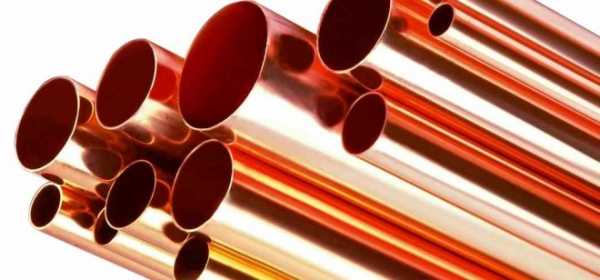

There are also copper pipes and stainless steel pipes. I will not write about them, since they are not in great demand. Of course, it is good to use copper pipes, a very good material, but due to the fact that copper is used as a material, their price is too high.
Stainless steel pipes are also great for heating your home, but again, they are expensive. Both options will also have problems with installation, since an appropriately qualified welder will be required, and it will be relatively problematic to hide such pipes behind a wall or in the floor.
If you want, you can independently search for information about these types of pipes. Well, that's all for me, I told you my opinion, from which pipes it is better to make heating, I wish everyone a successful installation, for now.
Steel pipes of the heating system: installation
Gravity (gravity) heating circuit diagram
For indoor heating systems, as a rule, ½- and ¾-inch pipes with a nominal diameter of 15 cm and 20 cm are used, respectively. The heating scheme is a system of series-connected sections of metal pipes of various lengths. The main requirements for this are the tightness and tightness of the entire circuit, regardless of temperature movements.
Installation of iron pipes is carried out in three ways:
- Using gas flame or electric arc welding;
- With flanges;
- With a threaded connection.
Installation and connection of pipelines using welding guarantees a strong and reliable connection. There are many types of welding, but when installing heating systems, installers often opt for gas or electric arc welding. Before starting welding, all joints and edges are thoroughly washed and degreased, and also treated with an abrasive tool (file, special chamfering machine, grinder, etc.).
In gas welding, under the influence of flame and high temperatures, the filler material (wire) melts, which forms the weld. Electric arc welding is performed using electrodes using direct or alternating current. In this case, the positive phase is connected to the workpiece, and the negative phase is connected to the electrode. Welding with alternating current is more cost effective, and the equipment for it does not require additional maintenance and testing.
Connecting pipes with a thread makes it possible to further dismantle and install individual sections of the heating circuit
Connecting pipes using a thread makes it possible to subsequently dismantle and install individual sections of the circuit for repair or replacement.When making such a connection, additional fittings are used:
- transitions,
- bends,
- traffic jams,
- stubs,
- connecting nuts,
- tees,
- couplings, etc.
And the question immediately arises, what quality characteristics should the fittings have? The answer is simple: all geometric dimensions of the connecting elements must comply with GOST, the thread must have a clear axial direction, be free from contamination and breaks.
All threaded connections are made using sealing materials. It can be impregnated linen tow, asbestos cord, paronite, rubber or FUM tape. Thoroughly clean the threads and sealing surfaces before carrying out the operations. All connections must be made to the end to ensure complete tightness. Pipe wrenches are used to screw pipes and fittings. Pipes are connected in special devices or directly at the installation site
Installation of pipes using flanges consists in bolting and sealing the sealing surfaces of the welded flanges. The sealing material can be asbestos cardboard, paronite, rubber, etc. The installation of the system must be carried out sequentially, excluding possible misalignment and distortions.
The gasket should be cut precisely to the size of the flange sealing surfaces, should not rest against the bolts and overlap. The bolts, in turn, should not be too long, and their heads should be marked on one side of the connection. It is necessary to tighten diametrically opposite nuts alternately for the entire connection. Use wrenches for this.
Summing up, I would like to say that, having complete information about steel pipes, you can easily determine which pipes are better and which type of their connection is more suitable for you. As practice shows, a high-quality metal pipe will last for decades and will not disappoint you.
In modern conditions, to create a heating system, you can use a wide variety of types of pipes: plastic, metal and metal-plastic. All of them can be used. Of course, each material is special, it differs not only in characteristics, cost, but also in installation requirements.
Heating pipes serve to supply and remove the required amount of heat. And at the moment, metal products are most often used for this.
Two-pipe heating system
Heating systems can be one- and two-pipe. The main feature of two-pipe heating systems is, as the name implies, that it involves the installation of two pipes. Hot water enters the heating system through the first, and the cooled coolant is discharged back into the system through the second. To shut off the heat supply, special taps are installed in front of the heating devices. The main advantage of a two-pipe heating system is to maintain the same coolant temperature for all software, although it will be relatively low. On the other hand, such a system provides cost savings - in this case, heating devices are used as efficiently as possible, there is no need to install additional sections on distant radiators.
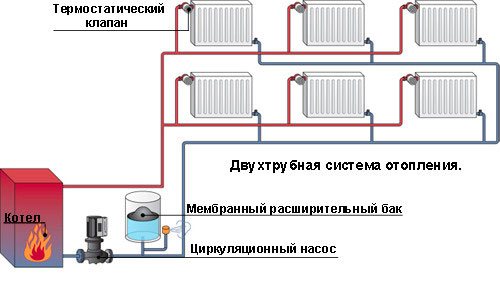

two-pipe heating system
Types of DSO:
- dead-end - water flows in opposite directions;
- flow-through - unidirectional flow of the coolant in pipes;
- vertical - they involve the installation of a large number of pipes, are ideal for multi-storey buildings, provide automatic air removal;
- horizontal - designed for installation in one / two-storey houses, special cranes "Mayevsky" are mounted on the radiators to bleed air.
The two-pipe heating system is suitable for installation in houses of any size, its properties are best manifested in large cottages.This option allows you to change the flow rate of some radiators bypassing the others; it is possible to use different room thermostats, which will provide comfortable conditions for all the inhabitants of the house.
Types of metal pipes
It is quite difficult to choose this material for heating. It must be resistant to environmental influences, must serve for a long time, be reliable and durable. Each metal has its own characteristics, which are worth considering further.
Stainless steel
This is almost an ideal option, if you do not take into account the rather high price for them and for installation. The products look great, have a high level of strength, are resistant to corrosion, and can be used for a hundred years.
Steel
Such pipes have high strength, serve for a long time, weld well. Also, such products are characterized by increased thermal conductivity. And this is very good just for the heating system. In addition, such material is inexpensive.
However, steel pipes are not without drawbacks. For example, they are susceptible to corrosion, so contact with water is not good for them. As a result, the inside of the pipe can become covered with rust, as a result of which it can overgrow. Therefore, the throughput will be degraded. As a result, replacement may often be required, which is not beneficial for heating.
Cink Steel
Galvanizing is needed just to protect steel from corrosion. However, this does not mean that the zinc coating will completely avoid this disadvantage. It will only slow down the process.
Recommendation: galvanizing of the connecting fittings is optional. Also, in the process of welding such material, substances hazardous to health are released. Therefore, it is better to make threaded or alternative connections.
Steel pipe corrosion
How air destroys metal:
- the water is saturated with air in the expansion tank and draws it into circulation;
- when the coolant is heated, air bubbles begin to actively separate from water molecules;
- metal, when interacting with water and air, begins to oxidize, corrosion appears. If there is no air, rust will not form.
For closed-type (sealed) systems, the problem of corrosion is not so acute, although air along with the coolant also enters the sealed circuit. To minimize this process, air separators are installed at the inlet, which, while stirring the flow, release oxygen bubbles from it and bring it out in an automatic mode. Another scourge of metal systems is the complexity of installation, which is associated with both the large weight of the structure and the necessary professional skills of the installer.
The service life of steel heating pipes made of ferrous metal is about thirty years. Stainless steel pipes for heating are almost eternal.
Copper
Such products have many advantages:
- bactericidal properties;
- high plasticity;
- the likelihood of corrosion is minimal;
- the service life is very long;
- resistance to temperature extremes;
- if water freezes, the material does not crack.
For all its ideality, copper pipes also have disadvantages. For them, mechanical impurities, as well as acidic water, are terrible. It should also be remembered that steel or galvanized products cannot be present in the same system with copper. Otherwise, corrosion may occur.
Such products can be welded or seamless. The latter are the most reliable material. This is one product, no components involved. The result is high strength. If necessary, the surface can be zinc plated to prevent rust formation.
In general, such a product does not require a protective coating such as a primer or paint. It is worth applying such compositions with your own hands only in places where the zinc coating is damaged - at the joints. Pipes can be connected with fittings.At the same time, we note that their material must be identical with the material of the pipes. Therefore, everything should be, say, copper or steel - depending on the material used.
As for welded pipes, they are very widespread. At the same time, modern technologies make it possible to obtain high strength of the welded seam. Therefore, such products are applicable where seamless ones are also used. Moreover, such products have less deviations in thickness, and the wall can be thin.
Hence the classification by thickness:
- lungs;
- ordinary;
- reinforced thickness. This is bad when bending is required, but good because it has high corrosion resistance.
Polypropylene pipes
One of the popular options for installing a heating system is its arrangement with polypropylene pipes. They are selected according to special standards: only those that can be used at high temperatures are used. That is, heating with a plastic pipe is possible, but at the same time it has a rigid framework for limiting the heating temperature. Increasing this parameter may change the shape of the pipe, as well as a rupture at the joints. Polypropylene pipes can be one-, three- or five-layer. Three-layer pipes have an inner aluminum or fiberglass layer, and pipes of 5 layers, in addition to the reinforcing composition, contain two layers of special hot melt glue. Most often, reinforced pipes are used for the heating system, consisting of exactly five layers. Reinforcement makes polypropylene hoses more reliable, durable, resistant to high temperatures and aggressive substances.
Like any other material, polypropylene has its positive and negative sides. The advantages include:
1. Low weight. A heating system made of polypropylene pipes does not increase the load on the supporting structures of a private house.
2. Durability: polypropylene pipes for heating have a service life of more than 20 years.
3. Resistance to low temperatures.
4. Almost absolute smoothness of the inner surface of the pipe - it is not covered with limescale.
5. Aesthetic appearance that does not require constant maintenance, in particular regular painting - the pipe does not change its color under the influence of high temperatures.
6. Possibility of installing a pipeline of complex configuration.


Unfortunately, in addition to all the positive points, polypropylene pipes for heating have their own disadvantages. This is a low maximum temperature of the coolant - up to 90 degrees (with short-term exposure), while the operating mode is completely equal to 70 degrees. The disadvantages include the complexity and laboriousness of replacing the damaged section of the pipeline. The price ranges from 33 rubles. up to 340 rubles. per running meter, depending on the diameter and material of the reinforcement.
Polypropylene single-layer pipes are not used in heating systems. Their main application is water supply.
Installation
Installing metal pipes for heating is not an easy task. Even small flaws can affect the service life or even render the system unusable.
Installation steps
First, a project is drawn up. The material, dimensions, scope of work are selected and the locations of the system elements are determined.
And only after that, direct installation is possible, taking into account, of course, the requirements of SNiP.
Making a heating system with your own hands is a pleasant, but painstaking and costly task, especially if metal products are used. Therefore, the priority will be the option of inviting the master to perform all installation work. If you have enough confidence, experience and knowledge, you can try it yourself. We make a choice, and go!
Today, many types of pipes are offered for heating systems: metal-plastic, plastic, metal.All of them are suitable for use in heat supply. They differ from each other only in the methods of installation, the material of which they are composed, the price and the service life.
Central heating pipes are designed to supply the quantity and remove the coolant from heating devices. For this, pipes from different materials are used, but in this article we will talk about metal pipes.
Criteria for choosing metal pipes for heating
When building a house and laying a heating system with your own hands, the main question arises - which metal pipes are better? As you know, metals used for communications are classified as:
- the black;
- color;
- alloys.
The first category includes rolled steel, galvanized iron and cast iron. Non-ferrous metals do not rust, but oxidize, these are:
- bronze;
- copper;
- aluminum, etc.
Attention! The service life of metal pipes for heating systems varies, and copper piping is at its maximum, but it is the most expensive. Most often they use metal pipes for heating made of cast iron and steel, stainless steel and aluminum.
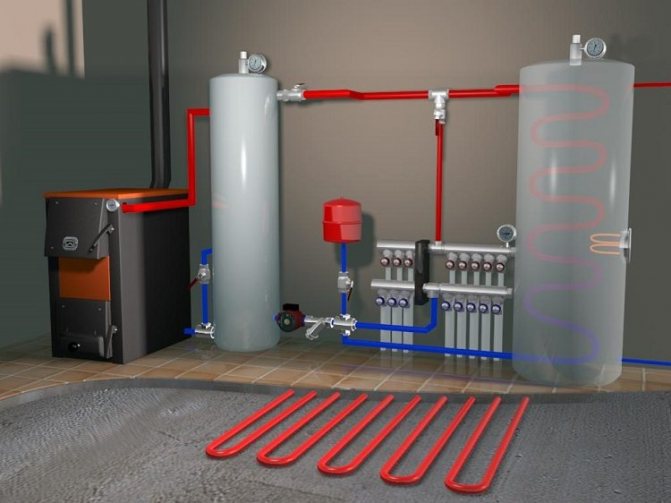

The type and layout of the heating system are one of the decisive factors when choosing pipes for the network
The main selection criteria:
- type of heating system (gravity or forced);
- maximum load (conditions of northern regions differ in terms of heating in southern latitudes);
- the possibility of replacing the pipeline sections with the highest load;
- installation method (hidden or closed, inside the walls);
- general configuration of the system, including the number of storeys in a private house;
- design and maximum pressure inside;
- type of coolant;
- do-it-yourself transportation and installation options;
- total length and budgetary framework for installation;
- maximum possible temperature in the system.
Varieties of metal pipes
It is very difficult to select pipes for heating, they are divorced around the entire perimeter of the house, and therefore must be resistant to corrosion, strong, reliable and last a long time.
There are certain types of pipes, consider some of them, their advantages and disadvantages:
Stainless steel pipes
Stainless steel metal pipes for heating.
They can be called ideal for a number of reasons:
- very long service life (100 years);
- high resistance to corrosion;
- high strength properties;
- great appearance.
Unfortunately, with all these high-class properties, there is a significant drawback - the high price of not only pipes, but also their installation will also cost you dearly. Very often this is the reason for favoring other types of pipes.
Steel tubes
They are made of high quality steel, which has high strength, excellent weldability and a relatively long service life. Steel pipes have a high thermal conductivity, but this advantage applies only to the heating system.
The main disadvantage is that steel pipes are not covered with anything and, in contact with water, this leads to metal corrosion. Corrosion is the cause of rusty water, the inner diameter of the pipe gradually overgrows, and this entails a decrease in water flow.
That is why steel pipes have a low price, but still need relatively frequent replacement.
Galvanized Steel Pipes
To avoid corrosion of steel pipes, a layer of zinc is applied to them, but this does not completely protect, but only slows down the corrosion process.
Tip: The connecting fittings must also be galvanized.
Important: In certain cases, the zinc coating of pipes is very harmful to the welder's health, since harmful substances are released during the welding process. Therefore, it is recommended to connect such pipes with threads.
Copper pipes
The advantages of these pipes are similar to those of copper itself:
- possesses bactericidal properties;
- has high plasticity;
- almost does not corrode;
- long service life;
- withstand sudden changes in temperature;
- when the water freezes in them - they do not crack, so you do not have to think about.
Metal pipes are manufactured using various technologies, for example, they can be seamless (seamless) or welded.
Solid-drawn metal heating pipes are perhaps the most reliable and high-quality material among all existing ones. They represent a single product (which is why they are called seamless) and are not assembled from component parts.
This makes them durable. They can be coated with zinc, which protects the pipes, and there is no need to take action to prevent rust formation.
Such pipes do not require painting or priming, only at the joints (they have threads, and with such a manipulation, the galvanized steel is damaged). Solid pipes, as well as welded pipes (galvanized or not galvanized), are connected to each other by special devices - couplings, and they are also called fittings.
Please note: If you have chosen metal pipes for heating, for example, stainless steel, then the fittings for them must be of the same material. That is, from what metal the pipes are the fittings.
Welded pipes are widely used in many industries. New and improved welding techniques guarantee a high seam strength that matches the strength of the pipe itself. All these technologies allow the use of welded pipes in those industries where it was possible to use only seamless pipes.
A welded metal pipe for heating, in comparison with a seamless one, is produced with less deviations in thickness and with a thinner wall. This technological feature is an advantage.
According to their thickness, pipes are of the following types:
- reinforced thickness;
- ordinary;
- lungs.
The large thickness of the metal has both a plus (high anti-corrosion performance) and a minus - they are very difficult to bend during installation and repair work.
Installing pipes for heating is a rather difficult and painstaking task when building or renovating a house. Minor errors can lead to a short service life or disable the entire system.
Installation features: general principles
The first thing you should pay attention to during installation is the volume of the proposed work. It is advisable to have on hand a drawn up plan diagram and decide on the choice of material. According to the measurements made in advance, the exact length of each pipe is indicated on the diagram, in order to thereby avoid additional costs.
Usually, either a reciprocating saw or a pipe cutter is used to cut pipes. Both methods are used in specific situations:
- The pipe cutter uses special cutting discs. They become dull over time and have to be changed.
- For stainless steel pipes, separate discs were invented, which are sharpened according to an improved technology and acquire increased strength.
It is not possible to use a pipe cutter in all cases. For example, this is impossible when you need to cut a part of the pipe from an already installed structure. In these cases, a reciprocating saw is used, which provides an even cut.
It is important! It is not recommended to use a grinder for cutting pipes, so as not to receive an electric shock as a result of a short circuit, when water from the pipe accidentally gets on the tool.
Threading also has its own characteristics. There are two types of cuts - cylindrical and conical. The choice depends on the type of project being built. After installation, the joint is sealed with flax or special tape.
When installing in hard-to-reach places, it is often necessary to bend the pipe. The pipe bender does this job best.
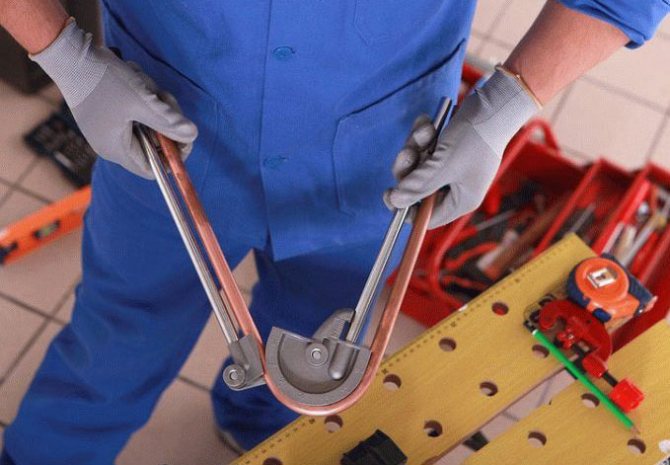

Sometimes the craftsmen change the design of the pipe in a handicraft way, for which they heat up the place of the intended bend and bend the pipes with their hands.
After completing all the work, it is necessary to check the heating. In the language of the master, this is called crimping.This stage of work is important, because when installing heating, you need to be sure that each element performs the functions assigned to it without any complaints.
Compliance is checked by artificially creating conditions in excess of operating conditions. This allows you to immediately notice the existing flaws that were made during the installation.
We recommend that you familiarize yourself with: Features of clips for fastening PVC pipes and rules for installing clips
The main stages of installing pipes for the heating system
- Mandatory drawing up of the project. At this stage, you need to decide on the amount of work, choose what material the equipment will be made of and what dimensions, think over the location of the parts of the heating system.
- Preparing the installation of pipes. Check the tools that are needed for serviceability and carry out preparatory work indoors.
- The actual installation of the pipes themselves.
Important: When installing the heating system, it is imperative to comply with the requirements of SNiP 41 - 01 - 2003.
Equipping your home on your own is pleasant and commendable, but it requires a lot of effort and certain financial costs, but even a small error can create everyday problems not only for you, but also for your neighbors. Heating from metal pipes must be carried out by a master who will ensure an uninterrupted heating system.
Services for the installation of heating water supply
DESIGN PRESTIGE LLC 8 (495) 744-67-74
In addition to fast and high-quality repair of heating pipes, we provide professional installation of turnkey heating systems. On our page by topic heating > resant.ru/otoplenie-doma.html For communication, use the contact phone number of DESIGN PRESTIGE LLC 8(495) 744-67-74, which you can call around the clock. note Our company DESIGN PRESTIGE LLC is a part of the non-profit organization ANO INTERREGIONAL COLLEGE OF JUDICIAL EXPERTS. We also provide services for an independent construction technical expertise.Heating from DESIGN PRESTIGE LLC Type: hot water here> /otoplenie-dachi.html



